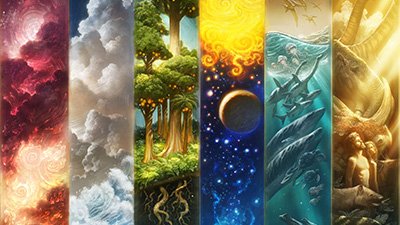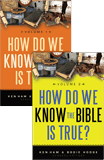
Connecting the Bible to the Real World
With a biblical framework in place, we can teach our children how the Bible explains the world around us.
We recently received an email from a lady in Kentucky that is representative of many. After attending the Creation Museum’s Autumn Evenings with her two young boys, she wrote:
“I am a homeschool parent, and my only regret is that we do not live closer to take the children to every workshop—or to enroll in some classes ourselves. I would love to see more curriculum for the younger children. I love creation science, but have no idea how to teach it.”
Other parents have expressed this same sentiment when leaving the Creation Museum—wow, this is all great, but how do I pass this information on to my kids? Christian school teachers, after hearing our speakers discuss the relevance of Genesis at a convention, wonder how they can incorporate this into their classrooms.
It’s a way of viewing science through the lens of Scripture.
While we offer a science curriculum for grades 1–9 and provide many other resources for children, let me suggest that the answer lies not so much in teaching “creation science,” as if it were a discipline separate from what you’re already teaching your kids. It’s not—it’s a way of viewing science through the lens of Scripture.
Instead, the answer to this mother’s question lies in adopting a biblically based worldview in which we connect the Bible to the real world in all areas—not just science. While this may seem a monumental task, as the Bible contains 66 books (some of which are rather long), we have developed a framework which keys in on seven events that have dramatically impacted the world. We call these the seven C's of history: Creation (Genesis 1–2), Corruption (Genesis 3), Catastrophe (Genesis 6–9), Confusion (Genesis 10–11), Christ (Genesis 12–the gospels), Cross (the gospels), Consummation (Revelation 21–22).
With this framework in place, we can teach our children how the Bible explains the world around us. Ken Ham suggests the following four areas to keep in mind as you work with this paradigm (these come from a chapter in his book Why Won’t They Listen?).
- We need to clearly teach what the Bible states. For instance, because it is God’s Word (and not just a human work), Scripture must be self-authenticating and self-attesting, and Scripture must interpret Scripture. Certainly, extrabiblical sources can be used to aid us in understanding the background against which it was written, but these sources must be secondary to the context of the Bible’s words themselves.
- Because the world is against the Bible, we must understand what the world is saying and doing in attacking and undermining the Bible, and thus counteract these false teachings.
- We need to logically defend what the Bible is teaching us, taking into account how the secular world (and even other Christians) attacks this point. Because many Christians have compromised with the world’s teachings, people need to be taught why these compromise positions are wrong, so they can defend their faith to other believers. This overlaps with point 4.
- The doctrine that comes out the biblical passage you’re discussing needs to be clearly enunciated. Then, apply it to our daily living.
The Seven C’s of History curriculum provides you with the material and information to learn and develop this framework—in your Bible time or family devotions. We’ve found that it’s not just for young kids—it also works well as a primer for people of all ages. The following points (and more!) are covered in this curriculum.
Creation
Bible passages: Genesis 1, 2
I enjoy gardening and when I plant a cantaloupe seed in our small garden plot, I expect to reap a harvest of cantaloupes. I can use this to explain the concept of “after their kind.” God created the original animals and plants “after their kind.” Because of this, we would expect to see animals and plants producing offspring similar to themselves, but wouldn’t expect to see one kind changing into another kind over millions of years. You can also delve into the differences between molecules-to-man evolution and natural selection and speciation if you have the inclination. And when the odd white flower pops up in your sea of pink Echinacea, you can talk about the role of mutations in today’s creation (although that may not necessarily be the reason for the white flower).
As you spend the night camping under the beautiful night sky, mention the purpose of the heavenly bodies: to mark off signs, seasons, days, and years for those of us on earth. Relate their origin: they didn’t come from a big bang, but instead were specially created by God on Day Four of that first week, just 6,000 years ago.
When you visit the zoo, stop by the chimp house. Point out the similarities and differences between humans and primates. Discuss that the Bible teaches we were created in the image of God, not in the image of apes. Mention that the alleged apemen were actually nothing of the sort.
Corruption
Bible passage: Genesis 3
My husband likes roses, so rose bushes surround our house. Of course, I need to wear gardening gloves when I’m pruning them so that I’m not pricked by the thorns. This provides a great opportunity to talk to kids about the introduction of thorns and thistles into the world after Adam sinned and to present the gospel.
When you talk about Grandpa’s recent death or little Annie’s leukemia with your children, do your discussions on sickness and death center upon “the natural order of things”? Or are you continually stressing that the “last enemy” is an intrusion into an originally very good creation—the decreed punishment for the sin of mankind (yours and mine)—but that Christ has declared victory over it, offers us salvation from it, and will eventually destroy it.
As you watch the Discovery Channel and gaze in wonder at the lion’s skillful attack on a zebra, do you marvel at the “way God designed it”? Or are you reminded that in the original creation, all animal kinds were vegetarian, and that the present-day dog-eat-dog world is an aberration which came about sometime after Adam sinned?
Catastrophe
Bible passages: Genesis 6–9
The roads where we live frequently pass through deep cuts in rock layers. During your drive, explain the rock layers you drive by were most likely formed during the Flood of Noah’s day just around 4,350 years ago—not over millions of years. The mountain peaks that we enjoy scaling and the valleys that we like to meander through are also testimonies to the watery catastrophe that God used to judge the sin of mankind.
As you hike through the woods and stumble upon a fossil, take time to discuss how a fossil in the middle of a forest in Indiana is linked to the event recorded in the true history book of the universe: the Bible. A field guide of common fossils found in your area can help you identify your finds. Use the field guide’s descriptions of the ages of the fossils to point out that the “millions of years” story attached to the fossils isn’t correct, but rather they were formed only thousands of years ago (at most).
There’s a small creek that runs through our property, and the stones we pull from it to line our garden are filled with fossilized sea creatures. Ask your kids: how can an area which is not covered by water today have fossils of creatures that live in the water?
When you’re exploring your local natural history museum and marveling at the colossal dinosaurs, mention the biblical timeframe: God created them 6,000 years ago on Day Six, along with Adam and Eve. The bones you’re looking at were most likely buried during the Flood of Noah’s day, but God saved a remnant on the Ark. Bring along your Bible and read Job 40 as you marvel at the size of one of the giant sauropods. Discuss some of the problems with the idea that dinosaurs have evolved into birds.
Show your kids your wife’s engagement ring. Talk about how the diamond (assuming it’s real!) formed in a short amount of time, not millions of years ago as some claim.
Confusion
Bible passages: Genesis 10–11
Many years ago, my aunt and uncle fostered a boy whose skin shade was a bit darker than ours. This gave me plenty of opportunities to share with others that any apparent differences between us are minor—we are not members of different races that have evolved at different times but are all part of the same family: the human race.
As your family sponsors missionaries to or children from other countries, discuss the original reason for the languages barriers that must be overcome. Remind them that the reason we are to preach the gospel to all the world is because we are all members of Adam’s fallen race (no matter where we live or what shade of brown our skin is). Jesus died to save sinners from all tribes and nations.
Christ / Cross
Bible passages: Genesis 12–the gospels
Christmas provides a great opportunity to connect the whole message of the Bible: the Creator came to earth to be our Savior, the Last Adam. As you read through the gospels, point out the verses that demonstrate both the humanity and deity of the Savior. Provide them with the information they need to respond to those who would claim that Jesus didn’t really rise from the dead. Show them that just as we accept that true account of the beginning of the world in Genesis, we also accept the biblical account that Jesus was conceived by a virgin, died, and rose again.
Consummation
Bible passages: 2 Peter 3:3–13; Revelation 21–22
This C can be tied into a discussion of any of the other C’s. When you discuss Creation, mention that in the future, animals will once again be vegetarian, just as they were in the beginning (Isaiah 65:25). As you talk about Corruption, discuss that the curse that God placed on His creation in Genesis 3 will one day be no more (Revelation 22:3). After teaching them about the Catastrophe of Noah’s day, share that the same God who judged the entire earth once with water will one day judge the earth with fire (2 Peter 3:3–13). Remind them that in the new heavens and earth, there will be people from every tribe and nation (Confusion). We have a responsibility today to share the good news of salvation through Jesus Christ with people around the world. During your studies on Jesus Christ and His finished work on the Cross, let your children know that the Creator who became our Redeemer is the one whom we will worship forever in that new creation.
Conclusion
As you can see, you don’t need a huge library or a PhD to instill in your children a worldview in which the Bible forms the basis for their lives and connects to every area. All it takes is a little reading and studying on your part and a little imagination to begin thinking of ways to incorporate what you’ve learned into the lives of your children. Although it may seem daunting at first, the rewards of training your children to understand the Bible and its connection to the real world are immense, and ultimately you’re bringing honor and glory to your Creator.
For more information:
- Creation Education Center (featuring free teaching resources)
- Answers Education Online
Recommended Resources

Answers in Genesis is an apologetics ministry, dedicated to helping Christians defend their faith and proclaim the good news of Jesus Christ.
- Customer Service 800.778.3390
- © 2024 Answers in Genesis






